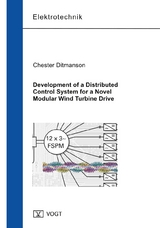Development of a Distributed Control System for a Novel Modular Wind Turbine Drive
Seiten
- Keine Verlagsinformationen verfügbar
- Artikel merken
In this work, the development of an electronic control system for a novel, highly modular, direct-drive wind turbine power converter and generator system is presented. The novel system features a flux-switching permanent magnet generator and the converter is composed of up to 12 parallel-connected low-voltage back-to-back two-level voltage source converters. The developed control system should equip each converter module with a local control platform, and a central control platform should perform central coordination tasks, including a novel multilevel modulation scheme of the grid-side converters. Other requirements for the control system include a high grid-side control frequency (24 kHz), and use of 100BASE-TX Ethernet equipment for communications. The system should both support fault-tolerance of the converter modules and be itself fault tolerant. For fault tolerance, it was chosen to implement a second, redundant central control platform which can immediately assume control of the system if it detects a failure of the active one.
Solutions in the literature all feature a lower number of modules, or a lower required control frequency. Most literature focuses on the ring network topology for scalability, but the high latency in a ring network is not compatible with a high module number and, simultaneously, a high control frequency. The literature on using Ethernet as a converter-internal communications medium is also scarce, although Ethernet for industrial fieldbus and motion control systems is well established. However, the latter are not optimal for use within a converter, since the performance of these solutions is insufficient for a power electronics system regarding determinism, latency, and synchronization. Regarding the redundant central controller, no literature was found addressing this in the context of a multi-module converter.
A solution was proposed here with a novel, light-weight Ethernet protocol. The proposed protocol operates by each platform continually re-transmitting small 40 byte packets at intervals of 5 μs to each directly connected communications partner. Advantages of this scheme include: low FPGA resource utilization, an inherent lost link watchdog capability, low latency, inherent communications reliability, and support for a novel synchronization scheme.
An in-depth analysis of synchronization among control platforms and the derivation of the novel synchronization scheme are another important contribution of this work. The novel synchronization scheme exploits the periodic transmission of the Ethernet packets to communicate timing information; the scheme limits synchronization error to 50 ns. Results of extensive testing are shown which verify that this synchronization error is always maintained, even after fail-over events to the redundant central controller.
The proposed solution was demonstrated to successfully control a 500 kW and a 3 MW test stand. It was demonstrated how the system continues operation without pause for failures of the active central controller or of local controllers or modules. The methods presented, as well as the analysis on synchronization, could be useful for other power electronics systems with distributed controllers.
Solutions in the literature all feature a lower number of modules, or a lower required control frequency. Most literature focuses on the ring network topology for scalability, but the high latency in a ring network is not compatible with a high module number and, simultaneously, a high control frequency. The literature on using Ethernet as a converter-internal communications medium is also scarce, although Ethernet for industrial fieldbus and motion control systems is well established. However, the latter are not optimal for use within a converter, since the performance of these solutions is insufficient for a power electronics system regarding determinism, latency, and synchronization. Regarding the redundant central controller, no literature was found addressing this in the context of a multi-module converter.
A solution was proposed here with a novel, light-weight Ethernet protocol. The proposed protocol operates by each platform continually re-transmitting small 40 byte packets at intervals of 5 μs to each directly connected communications partner. Advantages of this scheme include: low FPGA resource utilization, an inherent lost link watchdog capability, low latency, inherent communications reliability, and support for a novel synchronization scheme.
An in-depth analysis of synchronization among control platforms and the derivation of the novel synchronization scheme are another important contribution of this work. The novel synchronization scheme exploits the periodic transmission of the Ethernet packets to communicate timing information; the scheme limits synchronization error to 50 ns. Results of extensive testing are shown which verify that this synchronization error is always maintained, even after fail-over events to the redundant central controller.
The proposed solution was demonstrated to successfully control a 500 kW and a 3 MW test stand. It was demonstrated how the system continues operation without pause for failures of the active central controller or of local controllers or modules. The methods presented, as well as the analysis on synchronization, could be useful for other power electronics systems with distributed controllers.
| Erscheinungsdatum | 19.09.2017 |
|---|---|
| Sprache | englisch |
| Maße | 148 x 210 mm |
| Einbandart | Paperback |
| Themenwelt | Technik ► Elektrotechnik / Energietechnik |
| Schlagworte | control system • Turbine • Wind |
| ISBN-10 | 3-95947-017-7 / 3959470177 |
| ISBN-13 | 978-3-95947-017-9 / 9783959470179 |
| Zustand | Neuware |
| Haben Sie eine Frage zum Produkt? |
Mehr entdecken
aus dem Bereich
aus dem Bereich
Kolbenmaschinen - Strömungsmaschinen - Kraftwerke
Buch | Hardcover (2023)
Hanser (Verlag)
49,99 €




